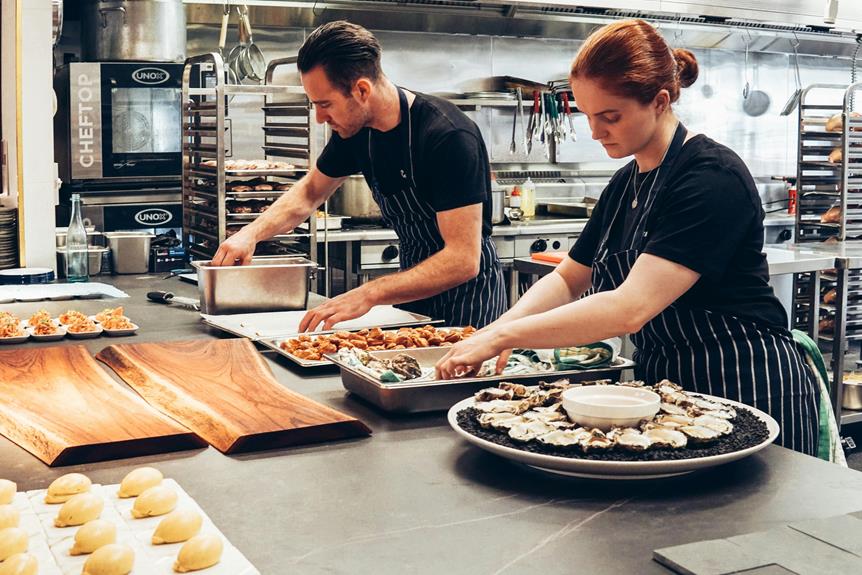To start an Italian restaurant, craft a solid business plan with realistic financial goals. Choose the right location by analyzing demographics and evaluating competitors. Design an authentic menu with traditional and modern dishes, catering to diverse dietary preferences. Acquire necessary permits and licenses to guarantee compliance with regulations. Hire skilled staff and promote your restaurant through social media and community events. Create a memorable dining experience by focusing on personalized service and cultural immersion. Manage finances and operations efficiently by creating a detailed budget plan and investing in staff training. Remember, success comes from attention to detail and strategic planning.
Key Takeaways
- Conduct thorough market research and competition analysis.
- Choose the right location based on demographic analysis.
- Design an authentic menu blending traditional and modern dishes.
- Obtain necessary permits and licenses to operate legally.
- Hire skilled staff and provide comprehensive training.
Crafting a Solid Business Plan

Crafting a solid business plan is essential when starting an Italian restaurant as it serves as a roadmap for your venture's success. To begin, thorough market research and competition analysis are vital. Understanding your target market's preferences and identifying your competitors' strengths and weaknesses will help you differentiate your restaurant and attract customers effectively.
When it comes to budgeting strategies, consider all costs involved in setting up and running your Italian restaurant. Factor in expenses for ingredients, kitchen equipment, staff wages, and marketing efforts.
Developing detailed growth projections based on your market research will allow you to set realistic financial goals and track your restaurant's performance over time.
Choosing the Right Location
Selecting the ideal location for your Italian restaurant is essential for attracting customers and ensuring the success of your business. Start by conducting thorough location scouting and demographic analysis. Consider areas with high foot traffic, ample parking, and proximity to your target market.
Evaluate the neighborhood's income levels, age groups, and dining preferences to match your offerings. Additionally, perform competitor assessment and target market research. Identify existing Italian restaurants in the vicinity and analyze their strengths and weaknesses.
Look for gaps in the market that you can fill or ways to differentiate your establishment. Understand the dining habits and preferences of your target demographic to tailor your menu and ambiance accordingly.
Designing an Authentic Menu
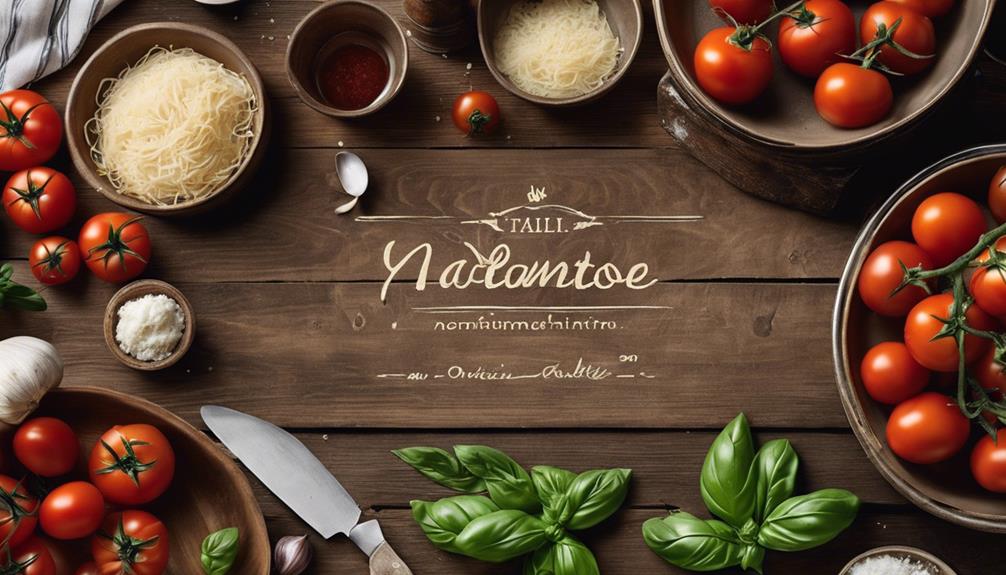
Developing an authentic menu is essential for establishing the identity and charm of your Italian restaurant. When designing your menu, consider the balance between traditional recipes and modern twists to cater to a wide range of tastes.
Incorporating classic Italian dishes like pasta carbonara and osso buco can attract customers looking for authentic flavors, while offering modern interpretations such as truffle-infused risotto or grilled vegetable lasagna can entice those seeking contemporary options.
Menu presentation plays an important role in enticing diners, so consider using enticing descriptions and appealing visuals to showcase your offerings. Additionally, be mindful of customer preferences by including vegetarian, vegan, and gluten-free options to accommodate varying dietary needs.
Conducting market research or gathering feedback from potential customers can help you understand what dishes are likely to be popular. By carefully curating your menu to strike a balance between tradition and innovation, you can create a dining experience that keeps customers coming back for more.
Obtaining Necessary Permits and Licenses
When starting an Italian restaurant, make sure you obtain all necessary permits and licenses to operate legally and smoothly. To meet the legal requirements, you'll need to go through the application process for various permits such as a business license, food service permit, and alcohol license if you plan to serve alcoholic beverages.
Each permit has its own set of compliance regulations and regulatory guidelines that must be strictly followed. The application process typically involves filling out forms, providing documentation, undergoing inspections, and paying fees.
It's important to familiarize yourself with the specific requirements of your local jurisdiction to guarantee you're in full compliance with the law. Failure to obtain the necessary permits and licenses can result in fines, closure of your restaurant, or even legal action.
Hiring Skilled Staff
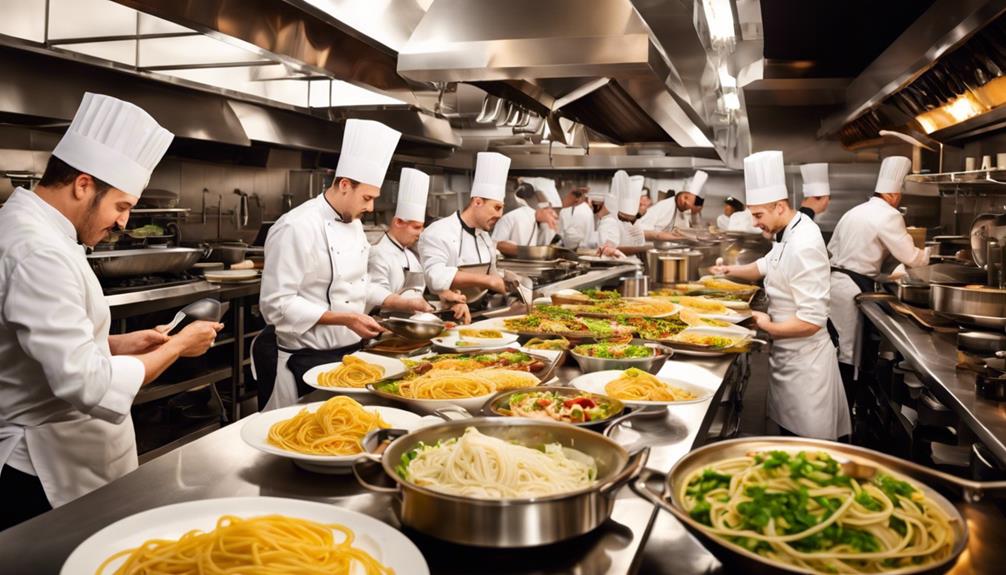
Make sure that your Italian restaurant is equipped with a competent and skilled staff to deliver high-quality service to your customers. Staff training and retention are vital aspects of maintaining a successful team. Provide thorough training to make certain that your staff is well-versed in Italian cuisine, customer service, and restaurant procedures.
Continuous training programs can help employees grow professionally and stay motivated.
Employee morale and motivation play a significant role in the success of your restaurant. Recognize and reward hard work, offer opportunities for advancement, and create a positive work environment to boost morale.
Encourage open communication and listen to your staff's feedback to address any concerns promptly.
To retain skilled employees, consider implementing incentive programs, providing competitive wages, and offering benefits such as healthcare and paid time off.
Fostering a sense of belonging and appreciation within your team will help reduce turnover and create a cohesive work environment focused on delivering exceptional service to your customers.
Sourcing Quality Ingredients
Elevate your Italian restaurant's reputation by carefully sourcing high-quality ingredients to enhance the authenticity and flavor of your dishes. To ensure you have access to the best ingredients, establish relationships with reputable ingredient suppliers. Look for suppliers who offer fresh produce, authentic Italian cheeses, high-quality meats, and imported specialty items. By partnering with reliable suppliers, you can guarantee the consistency and quality of your dishes, impressing your customers and setting your restaurant apart.
When creating your menu, draw inspiration from traditional Italian recipes and ingredients. Incorporate classic dishes like spaghetti carbonara, margherita pizza, and tiramisu, but don't be afraid to add your own twist. Experiment with seasonal ingredients and unique flavor combinations to keep your menu fresh and exciting for your customers.
| Ingredient Suppliers | Menu Inspiration |
|---|---|
| Local Farmers Markets | Traditional Pasta Dishes |
| Specialty Italian Grocers | Authentic Pizza Varieties |
| Premium Meat Suppliers | Classic Desserts with a Twist |
| Imported Cheese Retailers | Seasonal Ingredient Specials |
Setting Up an Efficient Kitchen
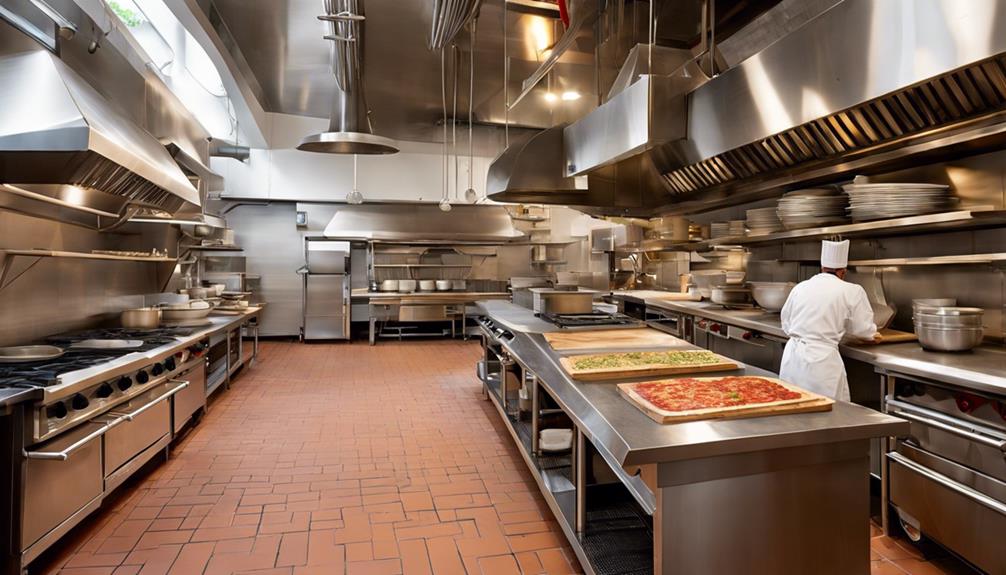
Consider streamlining your kitchen layout to optimize workflow and productivity in your Italian restaurant. A well-thought-out kitchen layout can make a significant difference in the efficiency of your operations.
Arrange your equipment strategically to minimize movement between stations, guaranteeing a smooth flow in the preparation process. Invest in high-quality equipment suitable for Italian cuisine, such as pasta makers, wood-fired ovens, and espresso machines, to enhance the authenticity of your dishes.
To further enhance workflow efficiency, establish clear organizational systems in your kitchen. Categorize ingredients based on their type and frequency of use, and store them accordingly for easy access. Implement standardized recipes and cooking procedures to maintain consistency and streamline the cooking process.
Additionally, make sure that your kitchen staff is well-trained and organized, assigning specific roles and responsibilities to each member to avoid confusion and overlap.
Marketing Your Italian Restaurant
To increase patronage and boost brand awareness for your Italian restaurant, focus on developing a thorough marketing strategy that targets your desired customer base. Utilize social media marketing to engage with your audience, showcase your delicious dishes, and promote any special events or promotions. Interacting with customers on platforms like Instagram and Facebook can help create a loyal following and encourage repeat visits.
Consider forming local partnerships with businesses in your area to cross-promote each other's services. Collaborating with nearby wine stores, grocery stores, or event venues can help expand your reach and attract new customers.
Hosting or sponsoring events in the community is another effective way to promote your restaurant. Whether it's participating in food festivals, organizing cooking classes, or hosting wine tastings, these events can create buzz and attract potential diners.
Creating a Memorable Dining Experience
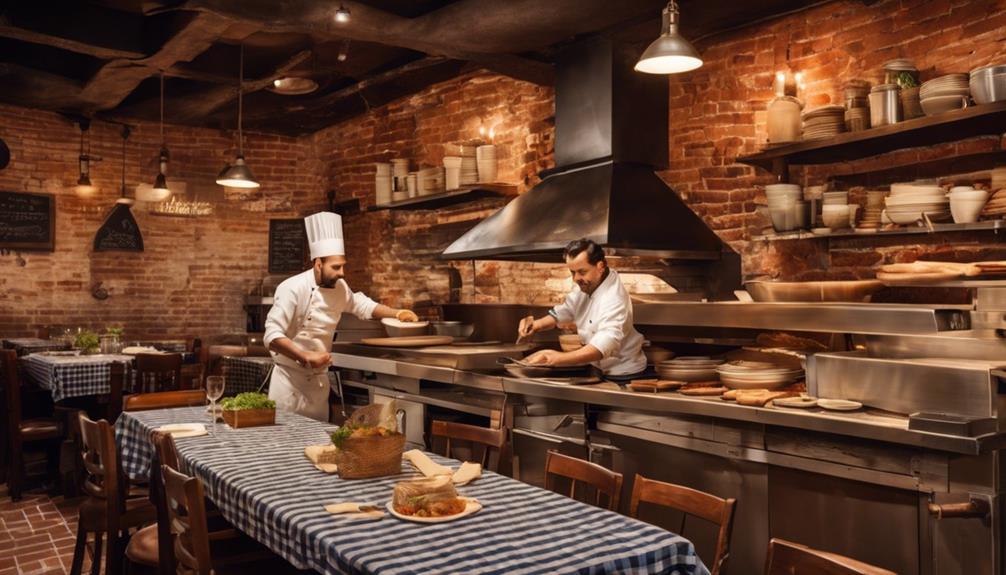
Craft an unforgettable dining experience at your Italian restaurant by focusing on attention to detail and personalized service for every guest. To create the perfect ambiance, consider elements like warm lighting, rustic decor, and cozy seating arrangements that transport diners to the heart of Italy.
Customer service excellence is essential; train your staff to be attentive, knowledgeable about the menu, and ready to cater to individual preferences.
Menu personalization is another vital aspect. Offer traditional Italian dishes while also providing options for customization based on dietary restrictions or personal tastes. Embrace cultural immersion by incorporating authentic ingredients, recipes, and cooking techniques that showcase the rich culinary heritage of Italy.
Ensure that every guest feels welcomed and valued from the moment they step through your doors until they leave. By paying close attention to ambiance creation, customer service excellence, menu personalization, and cultural immersion, you'll leave a lasting impression on every diner who visits your Italian restaurant.
Managing Finances and Operations
Guarantee efficient financial management and streamlined operations to sustain the success of your Italian restaurant. Start by creating a detailed budget plan that accounts for all expenses, including ingredients, staff wages, utilities, and marketing.
Monitor your finances regularly to make certain you stay within budget and make adjustments as needed. Invest in staff training to enhance customer service and increase productivity. Well-trained employees can positively impact operational efficiency and customer satisfaction.
To maintain cost control, analyze your expenses regularly and identify areas where you can cut costs without compromising quality. Negotiate with suppliers for better deals, minimize food waste, and optimize your menu to maximize profitability.
Implement technology solutions like POS systems to streamline operations and improve accuracy in tracking sales and inventory. Regularly review your financial reports to assess the performance of your restaurant and make informed decisions for growth.
Conclusion
Now that you have the tools and knowledge to start your own Italian restaurant, it's time to take action and make your dream a reality.
With a solid business plan, authentic menu, skilled staff, and effective marketing strategies, you'll be on your way to creating a successful dining experience for your customers.
Stay passionate, stay dedicated, and watch your Italian restaurant thrive in the competitive culinary world.
Good luck!
